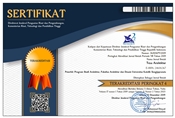Structural Value Of Empyak
Abstract
Empyak is a part of the traditional building that must be developed to preserve its existence. This paper explores the impact of construction method and structural behavior of empyak. The identification of how structurally work is essential as a primary information to develop the construction of empyak. Initially, a model with scale 1:3 was made to understand structural behavior under the seismic simulation. Some observation will be done to find out the changing of its shape under seismic forces. The results of this research are limited to understand the function of every element in the building stability. The result of the study will be useful for the development of traditional architecture. Empyak not only regards as a construction element but also as a structural element, which is the subject of the study.
Keywords: Empyak, structure, construction, bamboo
ABSTRAK
Empyak adalah salah satu elemen bangunan tradisional Yogyakarta yang perlu dilestarikan. Artikel ini membahas mengenai konstruksi empyak terhadap perilaku struktur bangunan keseluruhannya. Bagaimana empyak bekerja sebagai elemen struktural perlu dipelajari untuk dikembangkan dengan metode yang lebih modern. Pemahaman mengenai perilaku struktur empyak dilakukan dengan pengamatan model konstruksi dibawak berbagai karakter pembebanan. Observasi terhadap model berfungsi untuk mengetahui perubahan bentuk setelah dilakukan pembebanan. Penelitian ini dibatasi pada fungsi-fungsi struktural setiap elemen empyak untuk mendapatkan bangunan yang stabil. Penelitian ini bermanfaat untuk memahami bagaimana nilai-nilai konstruksi dan struktur yang ada dalam konstruksi empyak.
Keywords : Empyak, struktur, konstruksi, bambu
Keywords
Full Text:
PDFReferences
Baden-Powell, Charlotte. (2001). Architect's pocketbook/Charlotte Baden-Powell – [2nd ed.]. p. cm. Includes index ISBN 0 7506 4764 7. Burlington: Esevier
Cowan, Henry J. (1971). Architectural Structures: An Introduction to Structural Mechanics. American Elsevier: Newyork.
Crane, Theodore. (1947). Architectural Construction. John Wiley &Sons: New York.
Frick, Heinz. (1997). Pola Struktural dan Teknik Bangunan di Indonesia. Kanisius: Yogyakarta
Frick, Heinz. (2004). Ilmu Konstruksi Bangunan Kayu. Kanisius: Yogyakarta
Ghavami, K. (2008). Bamboo: Low cost and energy saving construction materials. Modern Bamboo Structures – Xiao et al. (eds) © 2008 Taylor & Francis Group, London, ISBN 978-0-415-47597-6
Hamzuri. Rumah Tradisiona Jawa. Proyek Pengembangan Permuseuman DKI Jakarta. Seri Rumah. Departemen Pendidikan dan Kebudayaan.
Ismunandar. (2007). Joglo : Arsitektur Rumah Tradisional Jawa. Effhar: Semarang
Jayanetti, D.L. & Follett, P.R. (2008). 23 Bamboo in construction. Modern Bamboo Structures – Xiao et al. (eds) © 2008 Taylor & Francis Group, London, ISBN 978-0-415-47597-6
Maer, Bisatya W. (2008). Respon Pendopo Joglo Yogyakarta Terhadap Getaran Gempa Bumi. DIMENSI TEKNIK ARSITEKTUR Vol. 36, No. 1, Juli 2008: 1 - 9
Marshall, W. T. (1969). Structures. London: Pitman
Prihatmaji, Yulianto P. (2007). Perilaku Rumah Tradisional Jawa “joglo” Terhadap Gempa. DIMENSI TEKNIK ARSITEKTUR Vol. 35, No. 1, Juli 2007: 1 – 12
Ravi Mullapudi, T., Ayoub, Ashraf. (2010). Modeling of The Seismic Behavior of Shear-critical Reinforced Concrete Columns. Journal Engineering Structures Vol. 32, Issue 11, Pages : 3601-3615
Schodek, Daniel L. (1997). Structure. Bandung: Refika Aditama.
Schierle, G.G. (2006). Architectural Structure Excerpts. Los Angeles: University of Southern California.
Soeroto, Myrtha. (2003). Dari Arsitektur Tradisional Menuju Arsitektur Indonesia. Galia Indonesia: Jakarta
Waterson, Roxana. (1998). The Architecture of South –East Asia through Travelers' Eyes. Oxford University Press: New York.
Widyowijatnoko, A. Prefabricated low-cost housing using bamboo reinforcement and appropriate technology.Modern Bamboo Structures – Xiao et al. (eds) © 2008 Taylor & Francis Group, London, ISBN 978-0-415-47597-6
DOI: https://doi.org/10.24167/tesa.v15i2.828
ISSN 1410-6094 (Print) | ISSN 2460-6367 (Media Online) | View My Stats

This work is licensed under a Creative Commons Attribution 4.0 International License.








